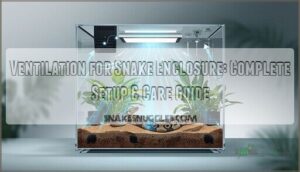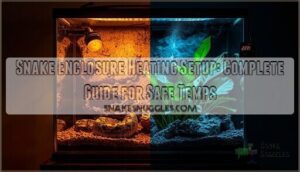This site is supported by our readers. We may earn a commission, at no cost to you, if you purchase through links.
Your snake’s breathing shouldn’t make noise. That’s the first thing most keepers miss until wheezing or bubbling sounds signal a problem that’s already taken hold.
Snake respiratory health hinges on an anatomy so specialized that when infections strike, they can escalate fast—pathogens like Pseudomonas exploit stressed animals, and conditions like poor ventilation or fluctuating humidity create the perfect storm.
The good news? Most respiratory infections are preventable. Understanding how your snake’s single functional lung operates, recognizing early warning signs like nasal discharge or open-mouth breathing, and maintaining proper enclosure conditions can stop problems before they start.
Table Of Contents
- Key Takeaways
- Snake Respiratory System Basics
- Common Respiratory Health Issues
- Signs of Respiratory Problems in Snakes
- Preventing Respiratory Infections
- Veterinary Diagnosis and Treatment
- Frequently Asked Questions (FAQs)
- Do snakes have respiratory problems?
- Are there medical treatments for respiratory diseases in snakes?
- What is effective snake respiratory infection care?
- Why is respiratory health important for snakes?
- Do snakes need to breathe?
- What causes respiratory distress in snakes?
- Can snakes get asthma or allergies like humans?
- Do different snake species have varying respiratory needs?
- How does brumation affect snake respiratory function?
- Can secondhand smoke harm my snakes breathing?
- Conclusion
Key Takeaways
- Silent breathing is normal for snakes, so any wheezing, clicking, or bubbling sounds signal a respiratory infection that’s already taken hold and needs immediate attention.
- Most respiratory problems stem from preventable husbandry mistakes—temperature swings, poor humidity control, and inadequate ventilation create conditions where bacteria like Pseudomonas thrive.
- Snakes rely on a single functional lung and intercostal muscles instead of a diaphragm, making them especially vulnerable when infections compromise their already-specialized breathing mechanics.
- Early intervention is critical because 70% of snakes showing open-mouth breathing or nasal discharge need veterinary care within 48 hours to avoid respiratory failure, which is the leading cause of snake mortality.
Snake Respiratory System Basics
Understanding how your snake breathes is the first step in keeping them healthy. Snakes have a respiratory system that’s built differently from other pets, and those differences matter when you’re watching for problems.
Let’s look at the key aspects of snake breathing that every owner should know.
Unique Anatomy and Function
Your snake’s respiratory system isn’t like yours at all. The tracheal function leads to an asymmetrical setup where the right lung dominates while the left often disappears entirely.
Here’s what makes snake anatomy noteworthy:
- Single functional lung manages all gas exchange in the vascularized anterior region
- No diaphragm means respiratory muscles between ribs do the heavy lifting
- Extendable glottis lets them breathe while swallowing massive prey.
Understanding the snake respiratory system is essential for maintaining their health.
How Snakes Breathe
Without a diaphragm, your snake relies on intercostal muscles between ribs to expand and contract the ribcage, moving air through the trachea into that dominant lung. The glottis—that small opening behind the tongue—controls airflow patterns and can even extend during feeding so breathing doesn’t stop.
Respiratory mechanics shift during activity: constricting prey means fewer breaths but bigger lung capacity usage, maintaining oxygen despite the squeeze. Understanding the snake’s respiratory system anatomy is vital for maintaining its overall health.
Factors Influencing Respiratory Health
Your snake’s breathing efficiency doesn’t happen in isolation. Environmental factors like temperature gradients and humidity control directly shape immune response strength—enclosure temperatures below species-specific ranges suppress defenses against respiratory tract infection.
Poor ventilation systems trap stale air and pathogens, while fluctuating conditions stress the system. Snake husbandry fundamentals determine whether your snake’s respiratory health thrives or struggles against reptile respiratory disease.
Common Respiratory Health Issues
Your snake’s respiratory system can run into trouble from several different sources, and knowing what you’re up against makes all the difference.
Some problems stem from infections—bacterial or viral invaders that take hold when conditions aren’t right. Others come from parasites or simply from an environment that’s stressing your snake’s defenses.
Bacterial and Viral Infections
Most respiratory infections in snakes stem from bacteria or viruses lurking in their environment. Gram-negative bacterial strains like Pseudomonas and Klebsiella dominate, often causing mixed infections—especially in pythons.
Serpentoviruses affect up to 67% of symptomatic snakes, triggering severe immune responses and high viral loads.
These respiratory pathogens exploit stressed or immunocompromised animals, making infection control through proper husbandry your first line of defense against bacterial and viral infections.
Parasitic Respiratory Diseases
Beyond bacteria and viruses, internal parasites like lungworms and pentastomes can wreak havoc on your snake’s respiratory health. These parasites pose significant respiratory parasitology challenges, requiring specialized identification methods such as tracheal washes or imaging.
Raillietiella orientalis now infects 18 Florida snake species, causing pneumonia and lung lesions. Wild-caught snakes face a higher risk of infection. Effective control of pentastomes demands targeted anthelmintic treatment combined with environmental management to break transmission cycles.
Environmental Triggers and Stressors
When your enclosure conditions veer off-target, you’re basically rolling out the red carpet for respiratory trouble. Environmental triggers and stress management are critical factors in snake respiratory health, given the unique demands of reptilian anatomy.
Here’s what undermines your snake’s defenses:
- Temperature gradients and fluctuations – Even slight shifts compromise immune function, leaving your snake vulnerable to opportunistic infections.
- Humidity levels outside the ideal range – Poor humidity control creates breeding grounds for pathogens and damages delicate respiratory tissues.
- Inadequate ventilation systems and environmental monitoring – Stale, damp air concentrates harmful microorganisms that directly attack respiratory health.
Signs of Respiratory Problems in Snakes
Catching respiratory trouble early can make all the difference for your snake’s recovery. The signs aren’t always obvious at first, but once you know what to look for, you’ll be able to spot problems before they become serious.
Here are the key symptoms that should prompt you to take a closer look at your snake’s health.
Wheezing and Audible Breathing
If your snake makes clicking, gurgling, or wheezing sounds when breathing, you’re hearing airway obstruction in action. These audible respiratory distress signals—often paired with labored breathing or open-mouth breathing—point to mucus buildup or inflammation from respiratory infection.
Snakes may stretch their necks upward to ease breathing difficulties, and stress or handling usually amplifies the wheezing sounds you’ll notice.
Nasal Discharge and Bubbling
Clear to mucopurulent nasal discharge—sometimes with visible bubbles at the nostrils—signals mucus production from respiratory infection. Respiratory sounds like gurgling confirm the infection’s grip on respiratory health.
You’ll notice blockage that makes breathing difficult, often accompanied by foamy saliva in the mouth. These bubbling symptoms indicate airway obstruction as your snake struggles to move air past accumulated secretions.
Open-mouth Breathing and Posture Changes
Ever watched your snake suddenly stretch out, lift its head, and gasp with its mouth wide open? That’s Respiratory Posture in action—a red flag for Respiratory Distress. Open-mouth breathing signals labored breathing and serious respiratory issues.
Watch for these changes in Snake Behavior:
- Elevated head posture
- Reduced coiling
- Increased Breathing Patterns
- Audible wheezing or clicking
Lethargy and Appetite Loss
Notice your snake lounging more than usual or ignoring food? That’s not just a lazy day—it’s a classic Lethargy Sign tied to Respiratory Stress. Appetite Decline often creeps in early with respiratory infection symptoms, making monitoring snake respiratory health vital.
These subtle shifts in behavior mean it’s time to focus on the Recovery Process and seek veterinary care promptly.
Preventing Respiratory Infections
Keeping your snake healthy starts with the right environment. Small changes in setup can make a big difference in preventing respiratory infections.
Here’s what you should look for in a proper enclosure.
Optimal Temperature and Humidity Control
With careful thermal monitoring and microclimate management, you can create ideal habitat conditions for snake respiratory health. Temperature gradients let your snake choose its comfort zone, while consistent humidity levels protect delicate airways.
Ventilation systems help balance moisture without trapping stale air. Think of it as weaving a safety net—each detail in reptile care helps prevent infections before they start.
Proper Enclosure Hygiene and Ventilation
Once your temperature and humidity are dialed in, Enclosure Cleaning and Ventilation Systems step up as the backbone of reptile enclosure management.
Air Quality Control starts with daily spot cleaning, smart Substrate Selection, and proper humidity management. Good ventilation—cross-vented or mechanical—keeps air fresh, reducing respiratory risk. Think of it as giving your snake a gust of clean air.
Stress Reduction and Handling Practices
Clean air is only half the battle—your handling techniques matter just as much for snake health. Stress mitigation starts with a gentle approach and short, predictable sessions. Environmental enrichment and calming strategies, like adding hides after interaction, help snakes rebound. Smart snake care means:
- Limit handling frequency
- Avoid rough or sudden movements
- Use full-body support
- Provide post-handling enrichment
Nutrition and Hydration Support
Beyond handling, your snake’s diet and fluid balance directly shape immune function. Dehydration intensifies respiratory disease risk—most snakes drink after losing 4–5% body mass, but illness changes those hydration thresholds. Nutrient deficiency, especially vitamin A, weakens defenses. Smart feeding strategies support recovery:
| Nutrition Factor | Respiratory Impact |
|---|---|
| Whole prey diet | Prevents vitamin deficiencies |
| Proper hydration | Facilitates gas exchange |
| Gradual refeeding | Avoids metabolic stress |
| Dietary supplements | Boosts immune function |
Feed dehydrated snakes cautiously—rapid feeding accelerates severe dehydration by over a week compared to fasting animals.
Veterinary Diagnosis and Treatment
When your snake shows signs of respiratory trouble, getting the right diagnosis quickly can make all the difference. Your vet has several tools to figure out what’s going on—from physical exams to lab work that pinpoints the exact cause.
Let’s walk through what to expect during diagnosis, treatment options, and how you’ll support your snake through recovery.
Diagnostic Tests and Procedures
When your snake shows respiratory signs, your vet will likely start with PCR testing to identify viral pathogens like serpentoviruses, which show up in about 26% of affected snakes. Diagnostic imaging—particularly CT scans—reveals structural lung changes, while endoscopy procedures allow direct visualization of the trachea and air sacs.
Histopathology analysis of biopsies distinguishes bacterial from viral causes, and serological screening detects asymptomatic carriers in your collection.
Antibiotic and Supportive Therapies
Most bacterial infections respond well to targeted antimicrobial therapy, but antibiotic resistance is rising—especially against penicillins and tetracyclines. Your vet will likely start with enrofloxacin or ceftazidime, often combining them for severe cases.
Nebulization therapy delivers medication directly to the respiratory tract. Therapy duration usually runs two to six weeks, paired with supportive care like fluid therapy and oxygen supplementation when needed.
Home Care and Recovery Management
Your convalescent care setup makes or breaks recovery. Most relapses—around 14–23% within three months—happen because enclosure conditions drift back to suboptimal ranges.
Here’s what truly moves the needle in home care:
- Hold that temperature gradient at 28–32°C for boids and pythons—immune function depends on it
- Keep humidity steady between 50–70% to help your snake clear mucous naturally
- Minimize handling completely—stress-induced immunosuppression prolongs illness in nearly half of cases
- Log symptoms daily—spotting trouble early cuts intervention time by 17%
Fresh water changed daily and spot-cleaning reduce secondary infections by 32%. Digital monitoring of temperature and humidity isn’t optional anymore—it’s your early warning system for relapse patterns.
When to Seek Veterinary Care
Don’t wait if you see open-mouth breathing, audible wheezing, or nasal discharge—70% of snakes showing these Emergency Signs need Urgent Attention within 48 hours to avoid Respiratory Failure. Lethargy paired with appetite loss signals Critical Care territory.
Early Veterinary Intervention cuts mortality by over half, so when symptoms appear, immediate veterinary care isn’t optional—it’s lifesaving for snake respiratory health.
When your snake shows respiratory symptoms, immediate veterinary care isn’t optional—it’s lifesaving
Frequently Asked Questions (FAQs)
Do snakes have respiratory problems?
Yes, they do. Respiratory issues affect about 6% of captive snakes, with viral infections like serpentovirus impacting up to 26% overall. Poor husbandry and stress often trigger these breathing difficulties in reptiles.
Are there medical treatments for respiratory diseases in snakes?
When your snake develops a respiratory infection, antibiotic therapy is the cornerstone of treatment. Veterinary medicine offers antimicrobial therapy like ceftazidime or enrofloxacin, often combined with snake nebulization and supportive care for positive treatment outcomes.
What is effective snake respiratory infection care?
Effective infection management combines antibiotic therapy targeting bacterial pathogens with respiratory support like oxygen and fluid therapy.
Your veterinary care provider guides treatment duration and adjustments based on your snake’s response to medication.
Why is respiratory health important for snakes?
Your snake’s breathing mechanics directly determine oxygen supply and immune function.
Respiratory failure is the leading cause of snake mortality—compromising gas exchange means even minor respiratory issues can quickly spiral into life-threatening disease.
Do snakes need to breathe?
Absolutely. Like all vertebrates, snakes are obligate air-breathers that rely entirely on their lungs for oxygen requirements and respiratory function.
Their unique respiratory adaptations—including specialized breathing patterns and single-lung anatomy—make air breathing mechanics essential for survival and metabolic activity.
What causes respiratory distress in snakes?
Poor ventilation, temperature swings, and excessive humidity create the perfect storm for respiratory infection.
Add stress from overcrowding or frequent handling, and your snake’s immune defenses start to crumble, inviting bacterial and viral respiratory disease.
Can snakes get asthma or allergies like humans?
No, snakes don’t develop asthma or respiratory hypersensitivity like mammals. Their immune response lacks the IgE-mediated mechanisms that trigger allergic reactions, making reptile sensitization fundamentally different from mammalian respiratory disease patterns.
Do different snake species have varying respiratory needs?
You’d think breathing would be universal, but arboreal snake species maintain vascular lungs as short as 9% of body length, while aquatic counterparts extend respiratory tissue nearly their entire body cavity—habitat influence drives dramatic breathing variability.
How does brumation affect snake respiratory function?
During brumation, your snake’s respiratory rate drops by over 50%, with metabolism falling below 30% of normal. This suppression reduces oxygen demand but increases infection risk if humidity or ventilation isn’t ideal.
Can secondhand smoke harm my snakes breathing?
Where there’s smoke, there’s trouble—and your snake’s single lung is no exception. Secondhand smoke causes respiratory infection, toxicity effects, and respiratory damage.
Air quality control protects snake respiratory health from these smoke exposure risks.
Conclusion
The moment you notice wheezing is often the same moment bacteria have already colonized your snake’s lung. But here’s the parallel: just as healthy wild snakes rarely develop respiratory illness, captive snakes in optimized environments resist infection naturally.
Your attention to temperature gradients, humidity levels, and stress signals directly determines your snake’s respiratory health. Master these fundamentals, and you’ll rarely need emergency vet visits—your snake will simply breathe silently, as nature intended.
- https://www.sciencedirect.com/book/9780323482530/maders-reptile-and-amphibian-medicine-and-surgery
- https://www.frontiersin.org/journals/veterinary-science/articles/10.3389/fvets.2019.00338/full
- https://vet.uga.edu/event/avian-reptile-small-mammal-endoscopy-online-on-demand-video-lecture-course/
- https://exoticskeeper.com/blog/understanding-respiratory-problems-in-snakes/
- https://www.bristol.ac.uk/vet-school/news/2022/snake-study.html














